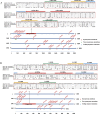Rapid and visual detection of 2019 novel coronavirus (SARS-CoV-2) by a reverse transcription loop-mediated isothermal amplification assay
- PMID: 32276116
- PMCID: PMC7144850
- DOI: 10.1016/j.cmi.2020.04.001
Rapid and visual detection of 2019 novel coronavirus (SARS-CoV-2) by a reverse transcription loop-mediated isothermal amplification assay
Abstract
Objective: To evaluate a reverse transcription loop-mediated isothermal amplification (RT-LAMP) assay for detection of severe acute respiratory syndrome coronavirus 2 (SARS-CoV-2), and compare it with RT-PCR.
Methods: We designed primers specific to the orf1ab and S genes of SARS-CoV-2. Total viral RNA was extracted using the QIAamp Viral RNA Mini Kit. We optimized the RT-LAMP assay, and evaluated it for its sensitivity and specificity of detection using real-time turbidity monitoring and visual observation.
Results: The primer sets orf1ab-4 and S-123 amplified the genes in the shortest times, the mean (±SD) times were 18 ± 1.32 min and 20 ± 1.80 min, respectively, and 63°C was the optimum reaction temperature. The sensitivities were 2 × 101 copies and 2 × 102 copies per reaction with primer sets orf1ab-4 and S-123, respectively. This assay showed no cross-reactivity with 60 other respiratory pathogens. To describe the availability of this method in clinical diagnosis, we collected 130 specimens from patients with clinically suspected SARS-CoV-2 infection. Among them, 58 were confirmed to be positive and 72 were negative by RT-LAMP. The sensitivity was 100% (95% CI 92.3%-100%), specificity 100% (95% CI 93.7%-100%). This assay detected SARS-CoV-2 in a mean (±SD) time of 26.28 ± 4.48 min and the results can be identified with visual observation.
Conclusion: These results demonstrate that we developed a rapid, simple, specific and sensitive RT-LAMP assay for SARS-CoV-2 detection among clinical samples. It will be a powerful tool for SARS-CoV-2 identification, and for monitoring suspected patients, close contacts and high-risk groups.
Keywords: COVID-19; Detection; RT-LAMP; SARS-CoV-2; Visual.
Copyright © 2020 European Society of Clinical Microbiology and Infectious Diseases. Published by Elsevier Ltd. All rights reserved.
Figures




References
-
- Bernard Stoecklin S., Rolland P., Silue Y., Mailles A., Campese C., Simondon A. First cases of coronavirus disease 2019 (COVID-19) in France: surveillance, investigations and control measures, January 2020. Euro Surveill. 2020;25:2000094. doi: 10.2807/1560-7917.ES.2020.25.6.2000094. - DOI - PMC - PubMed
Publication types
MeSH terms
Substances
Supplementary concepts
LinkOut - more resources
Full Text Sources
Other Literature Sources
Medical
Molecular Biology Databases
Miscellaneous

